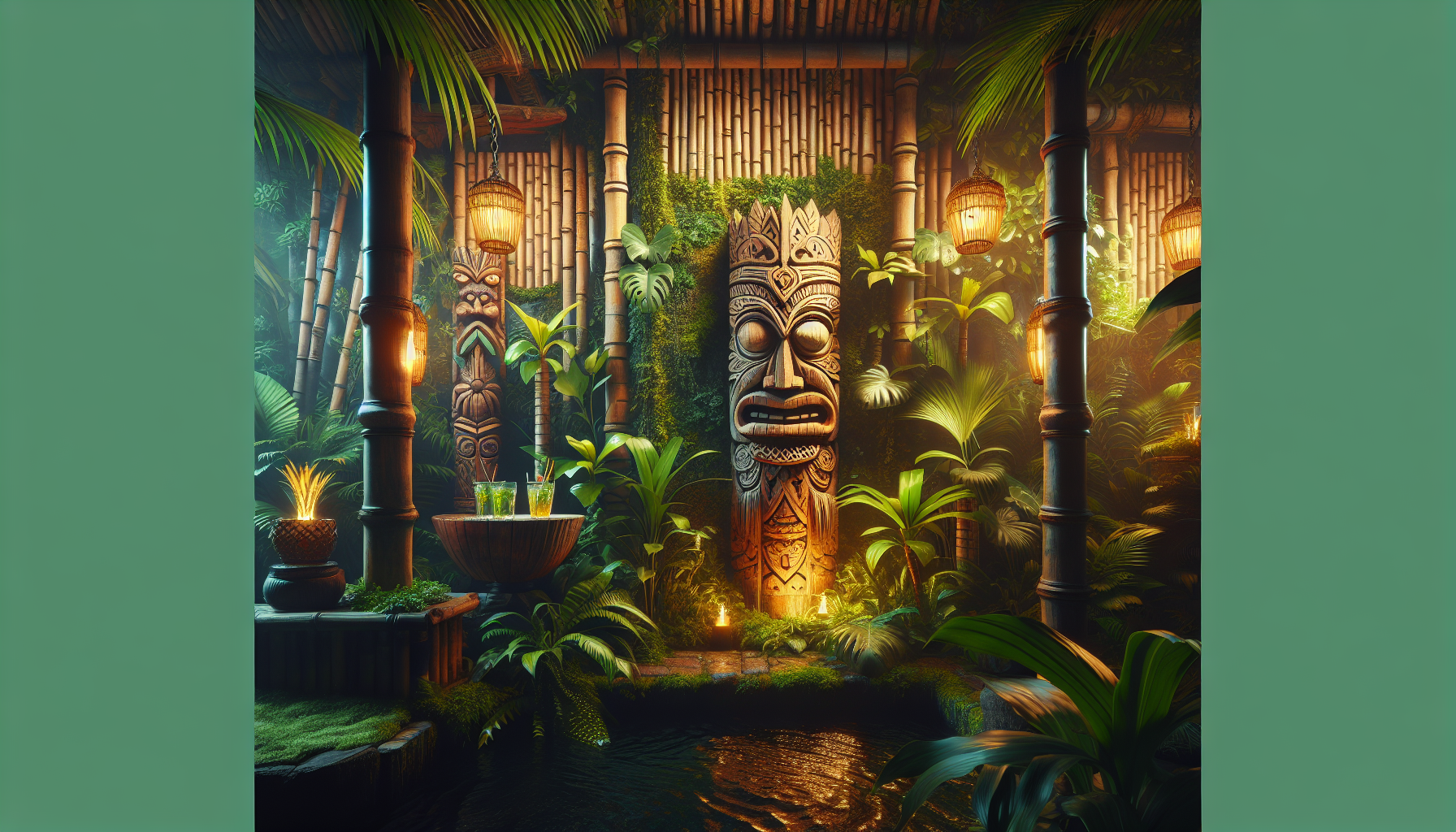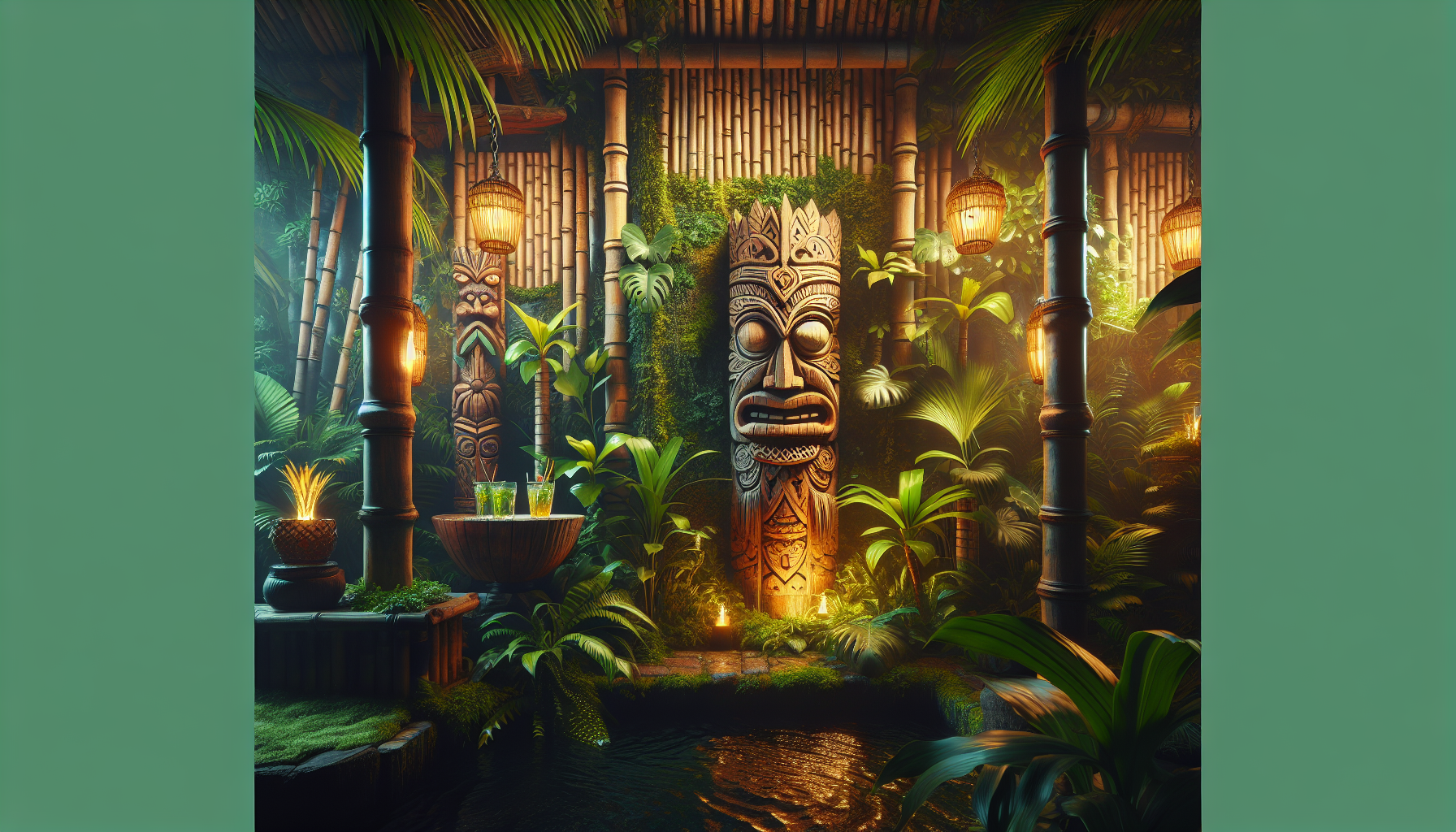Imagine stepping into a tropical oasis, surrounded by lush greenery, exotic decor, and the sound of waves crashing in the distance. This captivating journey takes you through the fascinating evolution of Tiki Bars, from their humble beginnings in the 1930s to the vibrant and diverse spaces they have become today. From the era of the first Polynesian-themed establishment to the present, this article delves into the rich history and transformation of Tiki Bars, inviting you to discover the allure and enduring charm of these unique destinations. So grab a Mai Tai, sit back, and embark on a delightful exploration of the evolution of Tiki Bars.
The Origins of the Tiki Bar
Tiki bars have become synonymous with tropical escapes, exotic cocktails, and a laid-back atmosphere. But where did it all begin? To trace the origins of the tiki bar, we have to go back to the 1930s, when two influential figures emerged in the United States, Don the Beachcomber and Trader Vic’s.
The Influence of Don the Beachcomber
Donn Beach, also known as Don the Beachcomber, is often credited as the founder of the tiki bar concept. In the early 1930s, he opened a small bar in Hollywood, California, which he decorated with palm fronds, tropical artifacts, and bamboo accents. This unique aesthetic was something entirely new at the time and quickly caught the attention of patrons looking for an escape from their everyday lives.
But it wasn’t just the décor that set Don the Beachcomber apart. He also introduced a revolutionary new style of cocktail that incorporated tropical flavors and ingredients. Drinks like the Zombie and the Navy Grog became instant hits, captivating customers with their complex layers of flavors and elaborate garnishes.
Trader Vic’s Contribution
While Don the Beachcomber was making waves on the West Coast, Victor J. Bergeron, better known as Trader Vic, was making his mark on the East Coast. In 1934, Trader Vic opened his first bar in Oakland, California, with a similar concept to Don the Beachcomber’s. However, Trader Vic added his own unique twist by focusing on rum-based cocktails and creating his signature drink, the Mai Tai.
Trader Vic’s Mai Tai quickly became a sensation, and it is still one of the most iconic tiki cocktails to this day. Its refreshing blend of rum, lime juice, and orgeat syrup perfectly captured the essence of the tropics, and its popularity helped solidify Trader Vic’s place in tiki culture.
Polynesian Pop Culture in the 1930s
The rise of tiki bars in the 1930s coincided with a growing fascination with Polynesian culture in America. The exotic appeal of the South Pacific, fueled by novels, movies, and World War II military service, captured the imagination of many.
Accompanying this cultural fascination was a trend in design and fashion known as “Polynesian Pop.” Bold patterns, vibrant colors, and tropical motifs began to appear in clothing, home decor, and architectural elements. Tiki bars embodied this trend, providing an immersive space where patrons could indulge in the fantasy of a tropical paradise.
The Rise of Tiki Bars in the 1940s and 1950s
Following their initial success, tiki bars experienced a surge in popularity in the 1940s and 1950s. Several factors contributed to this rise, including post-war escapism and the emergence of the exotica craze.
Post-War Escapism and the Exotica Craze
After World War II, Americans sought ways to escape the stresses of everyday life and find solace in the idea of tropical paradise. Tiki bars provided the perfect retreat, offering an idyllic ambiance complete with exotic drinks and Polynesian-inspired décor. People craved an experience that allowed them to momentarily forget about the hardships of war and immerse themselves in a tropical fantasy.
During this time, the exotica craze also took hold. Exotica music, characterized by lush instrumental arrangements and exotic rhythms, further fueled the allure of tiki bars. Artists like Martin Denny and Les Baxter created albums that transported listeners to faraway lands, evoking the same sense of escapism found in tiki bars.
The Birth of the Mai Tai and Other Iconic Tiki Cocktails
While the 1940s and 1950s witnessed the rise of tiki bars, it was also a pivotal period for the evolution of tiki cocktails. Building on the success of Trader Vic’s Mai Tai, bartenders began experimenting with different combinations of spirits, juices, and syrups, resulting in the creation of numerous iconic drinks.
One such cocktail was the Piña Colada, which first gained popularity during this era. This creamy blend of rum, pineapple juice, and coconut cream became a tropical staple and remains a beloved tiki classic. Other notable creations include the Blue Hawaii, the Zombie, and the Scorpion Bowl, each contributing to the rich tapestry of tiki cocktail lore.
Tiki Bar Aesthetic and Décor
Tiki bars of the 1940s and 1950s were renowned for their distinct aesthetic and décor. Bamboo walls, thatched roofs, and tiki statues created an immersive environment that transported patrons to a tropical paradise. Exotic plants, water features, and dim lighting added to the ambiance, creating a sense of mystery and intrigue.
The popularity of tiki mugs also emerged during this time, with intricately designed vessels becoming collectors’ items. These mugs, often in the shape of tikis or tropical animals, became a defining element of the tiki bar experience and a way for patrons to take a piece of the tropics home with them.

The Decline and Revival of Tiki Bars in the 1960s to 1990s
As the 1960s rolled around, tiki bars began to face challenges, with changing cultural landscapes and a decline in tiki culture overall.
Changing Cultural Landscape and the Decline of Tiki Culture
The 1960s brought about significant societal changes, including the civil rights movement and the Vietnam War. These shifts in the cultural and political landscape had a profound impact on the perception of tiki bars. Many viewed them as symbols of cultural appropriation and stereotypes, leading to a decline in their popularity.
Additionally, the rise of disco and other nightlife trends during this time shifted the focus away from tiki bars and towards more contemporary venues. As tastes changed, tiki culture started to fade, and many iconic establishments closed their doors.
The Influence of the Tiki Revival in the 1990s
Just as it seemed that tiki bars were destined to become relics of the past, a revival took place in the 1990s. A renewed interest in retro culture and a desire for nostalgia led to a resurgence of tiki bars and their unique allure.
Artists, bartenders, and enthusiasts who grew up during the heyday of tiki culture sought to preserve and celebrate the spirit of the past. They opened new tiki bars, meticulously restored old ones, and embraced the craftsmanship and attention to detail that defined the tiki aesthetic.
The Modern Tiki Bar Experience
Contemporary Tiki Bar Scene
Today, tiki bars have regained their place as popular destinations, offering an escape from the everyday and a taste of tropical paradise. While the heyday of the 1940s and 1950s may be gone, contemporary tiki bars continue to captivate patrons with their vibrant ambiance, creative cocktails, and immersive experiences.
Every corner of the world now boasts its own unique tiki bar scene, with establishments inspired by the original pioneers as well as those with a modern twist. From beachside retreats to urban hideaways, tiki bars provide an inviting space for people to unwind and indulge in the pleasures of the tropics.
Evolution of Tiki Cocktails and Mixology
Alongside the revival of tiki bars, there has been a renaissance in tiki cocktail culture. Bartenders have taken the classic recipes and techniques of the past and elevated them to new heights. Skillful mixologists experiment with fresh ingredients, house-made syrups, and innovative techniques to create cocktails that are both authentically tiki and uniquely modern.
While the Mai Tai and other iconic drinks remain perennial favorites, new additions to the tiki cocktail canon continue to emerge. The boundaries of flavor profiles are pushed, offering a wider range of options to satisfy the evolving palates of tiki enthusiasts.
Fusion of Tiki Culture with Other Culinary Styles
In recent years, tiki culture has transcended the traditional boundaries of its Polynesian roots and merged with other culinary styles. Chefs and bartenders have embraced the spirit of tiki and blended it with elements of other cuisines to create exciting and innovative flavor combinations.
Asian fusion, Latin American influences, and even elements of Scandinavian cuisine have found their way into tiki bars, adding a new layer of complexity and diversity to the world of tropical cocktails and cuisine. This fusion allows for endless possibilities and ensures that tiki culture continues to evolve and surprise.

The Future of Tiki Bars
Growing Popularity and Global Expansion
As tiki bars continue to captivate the imaginations of patrons around the world, their popularity shows no signs of waning. The allure of a tropical escape, the creativity of tiki cocktails, and the immersive ambiance continue to draw people in, making tiki bars a thriving and growing industry.
Tiki bars have also expanded beyond their traditional locations, with establishments popping up in unexpected places. From bustling city centers to remote island getaways, the global reach of tiki culture demonstrates its universal appeal.
Innovation and Adaptation to Current Trends
The future of tiki bars lies in their ability to innovate and adapt to current trends. As the tastes and preferences of patrons evolve, so too must the offerings of tiki establishments. This includes embracing sustainable and locally sourced ingredients, introducing new technological advancements in mixology, and staying attuned to the changing desires of consumers.
Furthermore, tiki bars will need to continue to foster a sense of community and inclusivity. By celebrating the diverse cultures and experiences that contribute to tiki culture, these establishments can create spaces that welcome people from all walks of life.
In conclusion, the tiki bar has come a long way since its origins in the 1930s. From the influential contributions of Don the Beachcomber and Trader Vic, to the rise, decline, and revival of tiki culture, these establishments have remained a beloved symbol of escapism and tropical paradise. With their rich history, vibrant cocktails, and immersive experiences, tiki bars are poised to continue their evolution and captivate audiences for years to come. So next time you find yourself seeking a break from the ordinary, just remember the allure of the tiki bar awaits you. Cheers!
